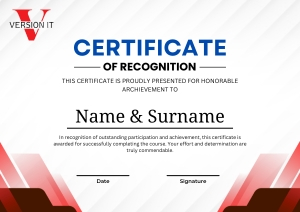Home > Courses > Full Stack Courses > Dot Net Full Stack > ASP.NET Course
ASP.NET Training in
Hyderabad
The ASP.NET framework of Microsoft is an excellent base for developing robust, scalable as well as highly efficient web applications of the present day. The technology has been applied for building dynamic sites, apps, as well as services. The ASP.Net training in Hyderabad is meant to give learners everything they need to use it effectively.
19 Modules
with Certifications
Certificate
After Completion
English
Language
Course Features:
Hyderabad has an experiential learning course in ASP.Net for developing professionals. It focuses on basic ASP.net concepts, MVC-based architectures and so forth. Individuals engage in hands-on projects in order to cultivate credible portfolios. Obtaining Version IT certification confirms skills and increases employability helping to get well-paid positions in reliable companies after graduation.
Best training on ASP.Net training in Hyderabad?
Version IT is considered one of the best ASP.Net training institutes in Hyderabad. It provides an inviting atmosphere, current facilities, and the knowledge that students need for success in the IT sector. Sign up for our ASP.Net program in Hyderabad and prepare to experience greatness as a web developer
Topics You will Learn
ASP.NET Training Course Objective
- Introduction to web technologies
- Web Forms Architecture
- ASP.Net and HTTP
- Web application developing using Visual Studio
- State Management and Web Applications
- ASP.Net Server-side controls
- Caching in ASP.Net
- ASP.Net application configuration
- Debugging, Diagnostics of application
- Connectivity with Database using ADO.Net/Entity Framework
- Data Access Controls
- Personalization and Security
- Introduction to Web Services
- Introduction to WCF
Introduction To Web Applications [Prerequisites]
- Types of Applications – Web, Desktop & Mobile Applications
- Web applications with Web Server
- Web Server role, about IIS, APACHE, and CASSINI
- Web Browsers, Web Support Languages
- Understanding http, TCP/IP, LAN, WAN & O/S role in web development
- Why Scripting & its importance
- Client-Side & Server-Side Scripting
OVERVIEW OF .NET (ASP.NET)
- Intro to .NET
- Drawbacks of Current Trend
- .NET Framework
- Key Design Goals
- CLR, CTS, MSIL, & Other Tools
- Multiple Language Interaction & Support
- Moving from Project to Assemblies…
- Security Services and environment
- Vista & IIS 6.0/7.0 & their requirements
- Installing & Configuring VS.NET/.NET 2.0/3.0/3.5
- AJAX(ATLAS) importance in Web applications
- The need for AJAX & the Solution
ACTIVE SERVER PAGES .NET ROLE
- Shifting from ASP to ASP.Net, Asp.net to web 2.0 (new)
- ASP.Net as Framework, Namespaces
- ASP.Net – New Scenario in development process with IDE – VS.NET
- Web Pages to Web Forms, HTML – ASP.NET, State management- an Important Objective
- Understanding the ASP.NET Execution Scenario
- C#.Net role in ASP.NET Development
- ASP.NET/C#.Net – the Industry approach
- HTML, HTML Controls, ASP.NET Controls
- Client-side & Server-side Controls
- Consuming HTML Client/Server Controls in WebForms
- Consuming ASP.Net Controls in WebForms
- Understanding the Rendering Nature of Controls Developing a Simple Startup Application
ASP.NET WEB FORMS – THE NEW TECHNOLOGY(BEGINNING)
- Introducing Web Forms, Worker process
- Working with Server Controls
- Applying Styles to Controls, Themes, Skins etc.
FORM
- Page Directives and its use
- Separating Code & Design
- New Code behind Techniques
- Implementing ASP.NET Server Controls
- Types of ASP.NET & their need/render
- Intrinsic – Validation – Bound – DataSource
- Navigation – Login – Web Parts & AJAX.-as building blocks Asp.net.
WEB FORMS – INTRODUCTION TO AJAX INPUT VALIDATION
- Validating Form with Validation Controls of Asp.net
- Using Required Field validator control
- Using Compare Validator Control Using Range Validator Control
- Using Custom Validator control
- Create Server-side / Client-side functions for – Custom Validator Control
- Group Validations & avoiding Validations.
- Finally – Client Targets & Validation Summary control
ADO.NET I – DATABASE SERVICES (V1.1/2.0/3.5)
- XML, XML to HTML, XML & Databases
- XML Schema Definition Tool
- Overview of ADO.NET/ XML Support in .NET
- Connect/Insert/Update/Delete,Query data -using ADO.NET
- Retrieve data with datasets
- Data Adapters, Understanding Data tables
- Build Data table programmatically
- Filter and sort Data table, Data Relations
- ADO.NET LINQ
ADO.NET – II
- Parameters with Command Object
- Stored Procedures with ADO.NET using –output parameters
- Develop a Registration form using ADO
PRESENTING DATA USING ASP.NET BOUND CONTROLS (USING VB.NET/C#)
- ASP.Net bound controls
- DataSource Controls
- Repeater & its uses.
- DataBound and DataAware Controls
- Bind data to Dropdownlist Control
- Datalist control
- DataGrid(1.1/2.0) Control
- GridView & its importance in Development
- GridView(Basic) – simple uses
- GridView (Advanced) –Runtime Fields, Empty DataRows, NTier …
- FormView & DetailsView
- ListView
AJAX (ATLAS )
- Introduction to Microsoft AJAX.(Code name ATLAS)
- XML Http object
- Programming with XML HTTP Object
- Advantages and Disadvantages of AJAX.
- Features of AJAX.
- MS Implementation of AJAX
ASP.NET ERROR HANDLING & DEBUG.
- Error Handling & .NET Runtime
- Avoid Errors before they occur
- Structured Error Handling
- Catching General Exceptions
- Catching Specific Exceptions
- Throwing Exceptions
- Custom Exceptions
- Page Level Error Handling
- Application Level Error Handling
USER CONTROLS
- Creating User Controls
- Adding member to user controls.
- Registering User Controls
- Properties & Methods
- Dynamically loading user controls
- Master Pages
CONFIGURING ASP.NET APPLICATION
- Web Application configuration-Advantages.
- New Configuration Model, ASP.NET Confn Tool
- Web Application Machine Configuration
- Global Assembly Cache, Strong Names VS2005.
- Working with Assembly Info
- Web.Config, Machine.Config
- Process Model –System Configuration.
ASP.NET WEB APPLICATIONS
- About Session & Application object
- Comparison between Session & Application
- Using the Global.asax file
- Managing Application State
- Http Handlers
- Application & Session Variables
- Application & Session Events
CACHE SERVICES
- Caching Overview
- Advantages of Caching
- Comparing with Application & Session var’s
- Page Output Caching
- Page Data Caching
- Fragment Caching
SECURITY
- Security Overview
- Authentication & Authorization
- Windows-based Authentication
- Passport Authentication.(WebServices)
- Forms-based Authentication
- Memberships
- Authorizing Users and Roles
- User Account Impersonation
DEPLOYMENT
- Deploying ASP.NET Application
ASP.NET XML WEB SERVICES
- Introducing XML Web Services
- Differences Between DCOM / Remoting / Web Services
- Asp.net Webservices.
- Writing a Simple Web Service
- Xml web services stack, SOAP,WSDL,UDDI,Sync an
- Async calls
- Web Service Type Marshalling
- Using Data in Web Services
- Using Objects and Intrinsic
- HTML Pattern Matching
- WCF
WEBPARTS
- New concept in Web Apps.
- Advantages and Disadvantages.
- Predefined/ user defined controls with webparts.
- Gadgets/side bars.
- Office 2007
- VS to VS.net tools for office.
WINDOWS VISTA-NEW FEATURES
- Gadgets/side bars.
- Office 2007
- VS to VS.net tools for office.
MOBILE APPLICATIONS
- Mobile forms
- Mobile Environment – Today’s Need.
- Needed Infrastructure
- WAP, WML overview.
- MS Mobile Explorer.
- Open ware Simulators.
- Line smart phones and Pocket PC Applications.
SMARTPHONE AND POCKET PC
- What is Smartphone / Pocket Pc?
- Application for smartphone / pocket pc
- Deploying / Run application in devices / Live
VSTO – VS.NET
- What is VSTO?
- Programming developing managed addings for outlook.
- Advantages VSTO
- VSTO 2005 SE
- Runtime component.
Additional Needed Services in Web Apps(Optional)
- MSMQ in ASP.Net
- Its need in data transferring
- MSMQ – Its role in heterogeneous networks and systems
- Crystal Reports in ASP.Net
- Designing Reports for Web Browsers
OVERVIEW
- SharePoint
- BizTalk
Let Your Certificates Speak

- Developing Secure and Scalable Web Applications with ASP.NET Certification
- Certifications improve your programming profile and are accepted across the world.
- Certificates are issued upon the course's conclusion.
All You Need to Start this Course
- C# is the primary programming language used by ASP.NET. It is essential to comprehend both fundamental and sophisticated C# ideas in order to work with ASP.NET efficiently.
- It helps to have a solid understanding of web development foundations including HTML, CSS, and JavaScript. Having a basic understanding of web application architecture, RESTful APIs, and HTTP is helpful while working with ASP.NET for web development.
Testimonials




Still Having Doubts?
Microsoft created the web application framework known as ASP.NET. It enables programmers to create dynamic web services and applications using VB.NET and C#, among other programming languages.
Key characteristics of ASP.NET comprise:
Server-side execution: Before being transmitted to the browser, ASP.NET code executes on the server.
State management: ViewState, Sessions, and Cookies are just a few of the methods that ASP.NET offers for maintaining state.
ASP.NET MVC and Web Forms: When creating web applications, developers have the option to use the classic Web Forms or the model-view-controller (MVC) paradigm.
Integrated security: Authentication and authorization methods are among the built-in security features of ASP.NET.
ASP.NET Core is a major rewrite of ASP.NET with the following notable distinctions:
Cross-platform: ASP.NET Core is intended to function on Windows, macOS, and Linux systems.
Lightweight and modular: Because ASP.NET Core is modular, developers may add just the parts they require. In addition, it is lighter than the conventional ASP.NET.
Performance: The enhanced performance and scalability of ASP.NET Core are well known.
Dependency injection: Dependency injection is supported natively by ASP.NET Core.


